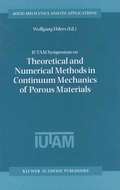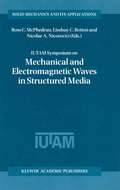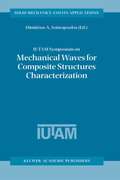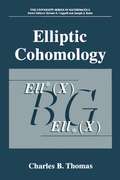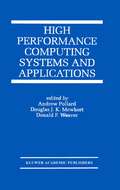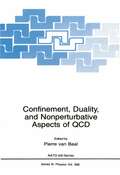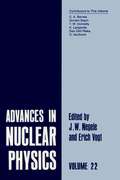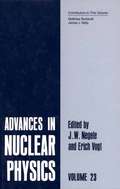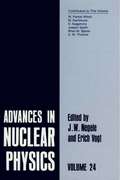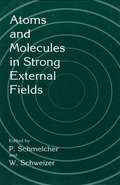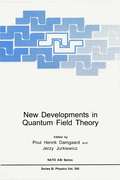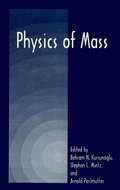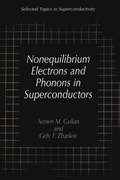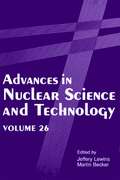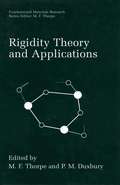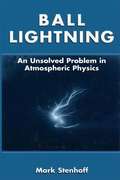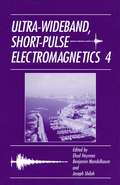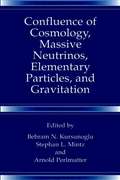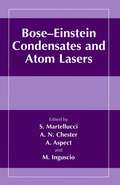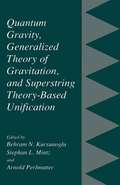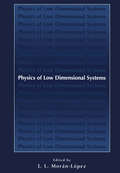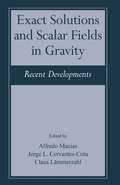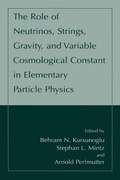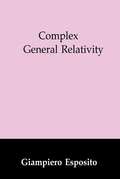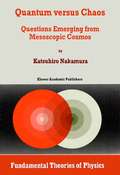- Table View
- List View
IUTAM Symposium on Theoretical and Numerical Methods in Continuum Mechanics of Porous Materials: Proceedings of the IUTAM Symposium held at the University of Stuttgart, Germany, September 5–10, 1999 (Solid Mechanics and Its Applications #87)
by Wolfgang EhlersDuring the last decades, continuum mechanics of porous materials has achieved great attention, since it allows for the consideration of the volumetrically coupled behaviour of the solid matrix deformation and the pore-fluid flow. Naturally, applications of porous media models range from civil and environmental engineering, where, e. g. , geote- nical problems like the consolidation problem are of great interest, via mechanical engineering, where, e. g. , the description of sinter materials or polymeric and metallic foams is a typical problem, to chemical and biomechanical engineering, where, e. g. , the complex structure of l- ing tissues is studied. Although these applications are principally very different, they basically fall into the category of multiphase materials, which can be described, on the macroscale, within the framework of the well-founded Theory of Porous Media (TPM). With the increasing power of computer hardware together with the rapidly decreasing computational costs, numerical solutions of complex coupled problems became possible and have been seriously investigated. However, since the quality of the numerical solutions strongly depends on the quality of the underlying physical model together with the experimental and mathematical possibilities to successfully determine realistic material parameters, a successful treatment of porous materials requires a joint consideration of continuum mechanics, experimental mechanics and numerical methods. In addition, micromechanical - vestigations and homogenization techniques are very helpful to increase the phenomenological understanding of such media.
IUTAM Symposium on Mechanical and Electromagnetic Waves in Structured Media: Proceedings of the IUTAM Symposium held in Sydney, NSW, Australia, 18–22 January 1999 (Solid Mechanics and Its Applications #91)
by Ross C. McPhedran Lindsay C. Botten Nicolae-A. P. NicoroviciThe IUTAM Symposium on Mechanical and Electromagnetic Waves in Structured Media took place at the University of Sydney from January 18- 22, 1999. It brought together leading researchers from eleven countries for a week-long meeting, with the aim of providing cross-links between the com- nities studying related problems involving elastic and electromagnetic waves in structured materials. After the meeting, participants were invited to submit articles based on their presentations, which were refereed and assembled to constitute these Proceedings. The topics covered here represent areas at the forefront of research intoelastic and electromagnetic waves. They include effect of nonlinearity, diffusion and multiple scattering on waves, as well as asymptotic and numerical techniques. Composite materials are discussed in depth, with example systems ranging fromdusty plasmas to a magneto-elastic microstructured system. Also included are studies of homogenisation, that field which seeks to determine equivalent homogeneous systems which can give equivalent wave properties to structured materials, and inverse problems, in which waves are used as a probe to infer structural details concerning scattering systems. There are also strong groups of papers on the localization of waves by random systems, and photonic and phononic band gap materials. These are being developed by analogue with semiconductors for electrons, and hold out the promise of enabling designers to control the propagation of waves through materials in novel ways. We would like to thank the other members of the Scientific Committee (A.
IUTAM Symposium on Mechanical Waves for Composite Structures Characterization: Proceedings of the IUTAM Symposium held in Chania, Crete, Greece, June 14–17, 2000 (Solid Mechanics and Its Applications #92)
by Dimitrios A. SotiropoulosThis book is a collection of selected reviewed papers that were presented at the International Union of Theoretical and Applied Mechanics Symposium "Mechanical waves for composite structures characterization". The Symposium took place June 14-17, 2000 in Chania, Crete, Greece. As is customary, IUTAM Symposia Proceedings are published in the series "Solid Mechanics and Its Applications" by Kluwer Academic Publishers. I am indebted to Professor G. M. L. Gladwell who is the series editor. I would also like to take this opportunity to express my sincere gratitude to Professor M. A. Hayes the Secretary General of the International Union of Theoretical and Applied Mechanics and a member ofthe Symposium's Scientific Committee. His constant encouragement and support made the Symposium not only possible but also successful. To the success also contributed all the members of the Symposium's Scientific Committee which I had the honor to chair. I express my appreciation to each one of them who are: Professor J. D. Achenbach (Northwestern University, Evanston, Illinois, USA), Professor M. A. Hayes (University College, Dublin, Ireland), Professor K. J. Langenberg (University of Kassel, Germany), Professor A. K. Mal (University of California, Los Angeles, USA), Professor X. Markenscoff (University of California, San Diego, USA), Professor S. Nair (Illinois Institute of Technology, Chicago, USA), Professor R. W. Ogden (University of Glasgow, UK), Professor G.
Elliptic Cohomology (University Series in Mathematics)
by Charles B. ThomasElliptic cohomology is an extremely beautiful theory with both geometric and arithmetic aspects. The former is explained by the fact that the theory is a quotient of oriented cobordism localised away from 2, the latter by the fact that the coefficients coincide with a ring of modular forms. The aim of the book is to construct this cohomology theory, and evaluate it on classifying spaces BG of finite groups G. This class of spaces is important, since (using ideas borrowed from `Monstrous Moonshine') it is possible to give a bundle-theoretic definition of EU-(BG). Concluding chapters also discuss variants, generalisations and potential applications.
High Performance Computing Systems and Applications (The Springer International Series in Engineering and Computer Science #541)
by Andrew Pollard Douglas J. K. Mewhort Donald F. WeaverHigh Performance Computing Systems and Applications contains the fully refereed papers from the 13th Annual Symposium on High Performance Computing, held in Kingston, Canada, in June 1999. This book presents the latest research in HPC architectures, distributed and shared memory performance, algorithms and solvers, with special sessions on atmospheric science, computational chemistry and physics. High Performance Computing Systems and Applications is suitable as a secondary text for graduate level courses, and as a reference for researchers and practitioners in industry.
Confinement, Duality, and Nonperturbative Aspects of QCD (Nato Science Series B: #368)
by Pierre Van BaalProceedings of a NATO ASI and Isaac Newton Institute Workshop held in Cambridge, UK, June 23-July 4, 1997
Advances in Nuclear Physics: Volume 22 (Advances in Nuclear Physics #22)
by John W. Negele Erich VogtThis volume presents five pedagogical articles spanning frontier developments in contemporary nuclear physics ranging from the physics of a single nucleon to nucleosynthesis in the Big Bang. Although the objectives of Advances in Nuclear Physics have been and will continue to be quite distinct from those of conventional conference proceedings, the articles in this volume are carefully edited and expanded manuscripts based on an outstanding series of lectures delivered at the VI J. A. Swieca Summer School in Brazil. Starting at the smallest scale, the first article by Dan Olof Riska addresses realistic chiral symmetric models of the nucleon. Since the analytic tools are not yet developed to solve nonperturbative QCD directly, significant effort has been devoted in recent years to the development of models which incorporate and are constrained by the approximate chiral symmetry manifested in QCD. This article provides a clear introduction to chiral symmetry and the Skyrme model, and discusses the Skyrme model’s relation to the chiral bag model, its extensions, and its application to nucleons and hyperons.
Advances in Nuclear Physics: Volume 23 (Advances in Nuclear Physics #23)
by J. W. Negele Erich W. VogtThis volume of Advances in Nuclear Physics addresses two very different frontiers of contemporary nuclear physics — one highly theoretical and the other solidly phenomenological. The first article by Matthias Burkardt provides a pedagogical overview of the timely topic of light front quantization. Although introduced decades ago by Dirac, light front quantization has been a central focus in theoretical - clear and particle physics in recent years for two majorreasons. The first, as discussed in detail by Burkardt, is that light-cone coordinates are the natural coordinates for describing high-energy scattering. The wealth of data in recent years on nucleon and nucleus structure functions from high-energy lepton and hadron scattering thus provides a strong impetus for understanding QCD on the light cone. Second, as theorists have explored light front quantization, a host of deep and intriguing theoretical questions have arisen associated with the triviality of the vacuum, the role of zero modes, rotational invariance, and renormalization. These issues are so compelling that they are now intensively investigated on their own merit, independent of the particular application to high-energy scattering. This article provides an excellent introduction and overview of the motivation from high-energy scattering, an accessible - scription of the basic ideas, an insightful discussion of the open problems, and a helpful guide to the specialized literature. It is an ideal opportunity for those with a spectator’s acquaintance to develop a deeper understanding of this important field.
Advances in Nuclear Physics: Volume 24 (Advances in Nuclear Physics #24)
by J. W. Negele Erich W. VogtThe three articles of the present volume pertain to very different subjects, all ofconsiderable current interest. The first reviews the fascinating history ofthe search for nucleon substructure in the nucleus using the strength ofGamow– Teller excitations. The second deals with deep inelastic lepton scattering as a probe ofthe non-perturbative structure of the nucleon. The third describes the present state ofaffairs for muon catalyzed fusion, an application of nuclear physics which many new experiments have helped to elucidate. This volume certainly illustrates the broad range ofphysics within our field. The article on Nucleon Charge-Exchange Reactions at Intermediate Energy, by Parker Alford and Brian Spicer, reviews recent data which has clarified one of the greatest puzzles of nuclear physics during the past two decades, namely, the “missing strength” in Gamow–Teller (GT) transitions. The nucleon-nucleon interaction contains a GT component which has a low-lying giant resonance. The integrated GT strength is subject to a GT sum rule. Early experiments with (n,p) charge exchange reactions found only about half of the strength, required by the sum rule, in the vicinity of the giant resonance. At the time, new theoretical ideas suggested that the GT strength was especially sensitive to renormalization from effects pertaining to nucleon substructure, particularly the delta excitation of the nucleon in the nucleus.
Atoms and Molecules in Strong External Fields
by P. Schmelcher W. SchweizerThis book contains contributions to the 172. WE-Heraeus-Seminar “Atoms and Molecules in Strong External Fields,” which took place April 7–11 1997 at the Phys- zentrum Bad Honnef (Germany). The designation “strong fields” applies to external static magnetic, and/or electric fields that are sufficiently intense to cause alterations in the atomic or molecular str- ture and dynamics. The specific topics treated are the behavior and properties of atoms in strong static fields, the fundamental aspects and electronic structure of molecules in strong magnetic fields, the dynamics and aspects of chaos in highly excited R- berg atoms in external fields, matter in the atmosphere of astrophysical objects (white dwarfs, neutron stars), and quantum nanostructures in strong magnetic fields. It is obvious that the elaboration of the corresponding properties in these regimes causes the greatest difficulties, and is incomplete even today. Present-day technology has made it possible for many research groups to study the behavior of matter in strong external fields, both experimentally and theore- cally, where the phrase “experimentally” includes the astronomical observations. - derstanding these systems requires the development of modern theories and powerful computational techniques. Interdisciplinary collaborations will be helpful and useful in developing more efficient methods to understand these important systems. Hence the idea was to bring together people from different fields like atomic and molecular physics, theoretical chemistry, astrophysics and all those colleagues interested in aspects of few-body systems in external fields.
New Developments in Quantum Field Theory (Nato Science Series B: #366)
by Poul Henrik Damgaard Jerzy JurkiewiczQuantum field theory is one of most central constructions in 20th century th- retical physics, and it continues to develop rapidly in many different directions. The aim of the workshop “New Developments in Quantum Field Theory”, which was held in Zakopane, Poland, June 14-20, 1997, was to capture a broad selection of the most recent advances in this field. The conference was sponsored by the Scientific and - vironmental Affairs Division of NATO, as part of the Advanced Research Workshop series. This book contains the proceedings of that meeting. Major topics covered at the workshop include quantized theories of gravity, string theory, conformal field theory, cosmology, field theory approaches to critical phenomena and the renormalization group, matrix models, and field theory techniques applied to the theory of turbulence. One common theme at the conference was the use of large-Nmatrix models to obtain exact results in a variety of different disciplines. For example, it has been known for several years that by taking a suitable double-scaling limit, certain string theories (or two-dimensional quantum gravity coupled to matter) can be re-obtained from the large-Nexpansion of matrix models. There continues to be a large activity in this area of research, which was well reflected by talks given at our workshop. Remarkably, large- Nmatrix models have very recently – just a few months before our meeting – been shown to have yet another deep relation to string theory.
Physics of Mass
by Behram N. Kursunogammalu Stephan L. Mintz Arnold PerlmutterSponsored by the Global Foundation, Inc., these proceedings are derived from the International Conference on Orbis Scientiae II. Topics covered include: gravitational mass, neutrino mass, particle masses, cosmological masses, susy masses, and big bang creation of mass.
Nonequilibrium Electrons and Phonons in Superconductors: Selected Topics in Superconductivity (Selected Topics in Superconductivity)
by Armen M. Gulian Gely F. ZharkovAdvances in Nuclear Science and Technology (Advances in Nuclear Science & Technology #26)
by Jeffery Lewins Martin BeckerSince its initiation in 1962, this series has presented authoritative reviews of the most important developments in nuclear science and engineering, from both theoretical and applied perspectives. In addition, many original contributions are included.
Rigidity Theory and Applications (Fundamental Materials Research)
by M. F. Thorpe P. M. DuxburyAlthough rigidity has been studied since the time of Lagrange (1788) and Maxwell (1864), it is only in the last twenty-five years that it has begun to find applications in the basic sciences. The modern era starts with Laman (1970), who made the subject rigorous in two dimensions, followed by the development of computer algorithms that can test over a million sites in seconds and find the rigid regions, and the associated pivots, leading to many applications. This workshop was organized to bring together leading researchers studying the underlying theory, and to explore the various areas of science where applications of these ideas are being implemented.
Ball Lightning: An Unsolved Problem in Atmospheric Physics
by Mark StenhoffDown comes a deluge of sonorous hail, Or prone-descending rain. Wide-rent, the clouds Pour a whole flood, and yet, its flame unquenched, Th’unconquerable lightning struggles through. Ragged and fierce, or in red whirling balls, And fires the mountains with redoubled rage. Black from the stroke, above, the smould’ring pine Stands a sad shattered trunk; and, stretched below, A lifeless group the blasted cattle lie. James Thompson, “The Seasons” (1727) have been investigating ball lightning for more than two decades. I published a ball lightning report in Nature in 1976 that received worldwide publicity and I consequently many people wrote to me with accounts of their own experiences. Within a very short time, I had accumulated about 200 firsthand accounts, and the file has continued to grow steadily since then. Several things impressed me. Few of those who wrote to me had any detailed foreknowledge of ball lightning at the time of their observation. Nonetheless, once reports of other phenomena such as St. Elmo’s fire had been eliminated, the remaining descriptions were remarkably consistent. Furthermore, nearly all who contacted me were keen to have an explanation of what they had seen and seemed entirely sincere.
Ultra-Wideband Short-Pulse Electromagnetics 4
by Ehud Heyman Benjamin Mandelbaum Joseph ShilohIn the tradition of the previous three conferences, the proceedings of the 4th Ultra-Wideband Short-Pulse Electromagnetics Conference explores topics including pulse generation and detection; broadband electronic systems; antennas - theory, design, experiments and systems; pulse propagation; scattering theory; signal processing; and buried targets - detection and identification.
Confluence of Cosmology, Massive Neutrinos, Elementary Particles, and Gravitation
by Behram N. Kursunogammalu Stephan L. Mintz Arnold PerlmutterJustbefore the preliminary programof Orbis Scientiae 1998 went to press the news in physics was suddenly dominated by the discovery that neutrinos are, after all, massive particles. This was predicted by some physicists including Dr. Behram Kusunoglu, who had apaper published on this subject in 1976 in the Physical Review. Massive neutrinos do not necessarily simplify the physics of elementary particles but they do give elementary particle physics a new direction. If the dark matter content ofthe universe turns out to consist ofneutrinos, the fact that they are massive should make an impact on cosmology. Some of the papers in this volume have attempted to provide answers to these questions. We have a long way to go before we find the real reasons for nature’s creation of neutrinos. Another neutrino-related event was the passing of their discoverer, Fredrick Reines: The trustees of the Global Foundation, members of the Orbis Scientiae 1998, dedicate this conference to Fredrick Reines of the University of California at Irvine. The late Professor Reines was a loyal and active member of these series of conferences on the frontiers of physics and cosmology since 1964. He also sewed as one of the trustees of the Global Foundation for the past three years. Professor Reines discovered the most elusive particle, the neutrino, in 1954. We are proud to say that we recognized the importance of this discovery by awarding him the J.
Bose-Einstein Condensates and Atom Lasers
by S. Martellucci Alain Aspect Arthur N. Chester Massimo InguscioProceedings of the International School of Quantum Electronics 27th course on Bose Einstein Condensates and Atom Lasers, October 19-24, 1999, Erice, Italy. Since the experimental demonstration of Bose Einstein Condensation in dilute atomic gases there has been an explosion of interest in the properties of this novel macroscopic quantum system. The book covers the methods used to produce these new samples of coherent atoms, their manipulation and the study of their properties. Emphasis is given to the anticipated development of new types of sources, which more and more resemble traditional types of lasers. Because of recent new applications and increasing demand for lasers, sensors and associated instrumentation, the chapters also cover current developments in the basic techniques, materials and applications in the field of the generation of coherent atoms.
Quantum Gravity, Generalized Theory of Gravitation, and Superstring Theory-Based Unification
by Behram N. Kursunogammalu Stephan L. Mintz Arnold PerlmutterPhysics of Low Dimensional Systems
by J. L. Morán-LópezOaxaca, Mexico, was the place chosen by a large international group of scientists to meet and discuss on the recent advances on the understanding of the physical prop- ties of low dimensional systems; one of the most active fields of research in condensed matter in the last years. The International Symposium on the Physics of Low Dim- sions took place in January 16-20, 2000. The group of scientists converging into the historical city of Oaxaca, in the state of the same name, had come from Argentina, Chile, Venezuela, several places in Mexico, Canada, U. S. A. , England, France, Italy, Germany, Russia, and Switzerland. The presentations at the workshop provided sta- of-art reviews of many of the most important problems, currently under study. Equally important to all the participants in the workshop was the fact that we had come to honor a friend, Hans Christoph Siegmann, on his sixty-fifth birthday. This Festschrift recognizes the intellectual leadership of Professor Siegmann in the field and as a sincere homage to his qualities as an exceptional friend, college and mentor. Those who have had the privilege to work closely with Hans Christoph have been deeply impressed by his remarkable analytic mind as well as by his out of range kindness and generosity. Hans Christoph has contributed to the understanding of the difficult and very important problem of the magnetic properties of finite systems: surfaces, thin films, heterostructures.
Exact Solutions and Scalar Fields in Gravity: Recent Developments
by Alfredo Macías Jorge L. Cervantes-Cota Claus LämmerzahlDivided into four parts, this book covers recent developments in topics pertaining to gravity theories, including discussions on the presence of scalar fields. Part One is devoted to exact solutions in general relativity, and is mainly concerned with the results of rotating null dust beams and fluids. Also included is a panoramic vision of new research directions in this area, which would require revising certain theorems and their possible extensions within gravity theories, new aspects concerning the Ernst potentials, double Kerr spacetimes, and rotating configurations. In particular, there is a detailed discussion of totally symmetric and totally geodesic spaces, in which a method for generating (2+1)-dimensional solutions from (3+1)-dimensional solutions is given. Part Two deals with alternative theories of gravity, all of which include scalar fields and gauge fields. Here, quantum and cosmological effects, which arise from both gravity theories in four and higher dimensions and from metric-affine theories, are investigated. Part Three is devoted to cosmological and inflationary scenarios. Local effects, such as the influence of scalar fields in protogalactic interactions, numerical studies of the collapse of molecular cores, as well as the inverse inflationary problem and the blue eigenvalue spectrum of it, are considered. Moreover, the role of scalar fields as dark matter and quantum cosmology in the Bergman-Wagoner and Gowdy theories, together with the relation of the conformal symmetry and deflationary gas universe, are likewise presented. The last part of the book includes some mixed topics which are still in the experimental stage. Among them are the foundation of the Maxwell theory, a discussion on electromagnetic Thirring problems, a note on the staticity of black holes with non-minimally coupled scalar fields, and a study of the Lorentz force free charged fluids in general relativity. Thus, this book is the most up-to-date, comprehensive collection of papers on the subject of exact solutions and scalar fields in gravity and is a valuable tool for researchers in the area.
The Role of Neutrinos, Strings, Gravity, and Variable Cosmological Constant in Elementary Particle Physics
by Stephan L. Mintz Arnold Perlmutter Behram N. Kursunogammaluth The 29 International Conference was held as the first one of the millennium at its Fort Lauderdale venue. These conferences began, with High Energy Physics being the main topic, by introducing gradually cosmology into its programs. These proceedings of the 2000 conference reflect the variety of topics and ideas discussed. Our future conferences will be designed somewhat akin to the early Coral Gables Conferences where we shall seek some convergence of ideas. For this reason various committees have been formed from among the participating physicists. The committees and their memberships are listed in these proceedings. We further decided for the first time to include some graduate student participants in our future meetings for which also a committee has already been established. The topics will demonstrate a more activist structure of the Coral Gables Conferences, for example the duality of the gravitational forces and expansion of the universe will be discussed from this point of view since it conveys a convergence to the ideas of quintessence versus the ordinary theory, which are considered as the cause of the expansion of the universe. We further wish to announce that the future conferences will assume a collective organization where several committees as listed in these proceedings will have their input into the conference. We have now introduced new topics and ideas, which referred especially to the attractive and repulsive nature of the gravitational force. These proceedings of the conference contain a variety of topics and ideas.
Complex General Relativity (Fundamental Theories of Physics #69)
by Giampiero EspositoThis book is written for theoretical and mathematical physicists and mat- maticians interested in recent developments in complex general relativity and their application to classical and quantum gravity. Calculations are presented by paying attention to those details normally omitted in research papers, for pedagogical r- sons. Familiarity with fibre-bundle theory is certainly helpful, but in many cases I only rely on two-spinor calculus and conformally invariant concepts in gravitational physics. The key concepts the book is devoted to are complex manifolds, spinor techniques, conformal gravity, ?-planes, ?-surfaces, Penrose transform, complex 3 1 – – space-time models with non-vanishing torsion, spin- fields and spin- potentials. 2 2 Problems have been inserted at the end, to help the reader to check his und- standing of these topics. Thus, I can find at least four reasons for writing yet another book on spinor and twistor methods in general relativity: (i) to write a textbook useful to - ginning graduate students and research workers, where two-component spinor c- culus is the unifying mathematical language.
Quantum versus Chaos: Questions Emerging from Mesoscopic Cosmos (Fundamental Theories of Physics #87)
by K. NakamuraQuantum and chaos, key concepts in contemporary science, are incompatible by nature. This volume presents an investigation into quantum transport in mesoscopic or nanoscale systems which are classically chaotic and shows the success and failure of quantal, semiclassical, and random matrix theories in dealing with questions emerging from the mesoscopic cosmos. These traditional theories are critically analysed, and this leads to a new direction. To reconcile quantum with chaos and to restore genuine temporal chaos in quantum systems, a time-discrete variant of quantum dynamics is proposed. Audience:This book will be of interest to graduate students and researchers in physics, chemistry and mathematics, whose work involves fundamental questions of quantum mechanics in chaotic systems.
